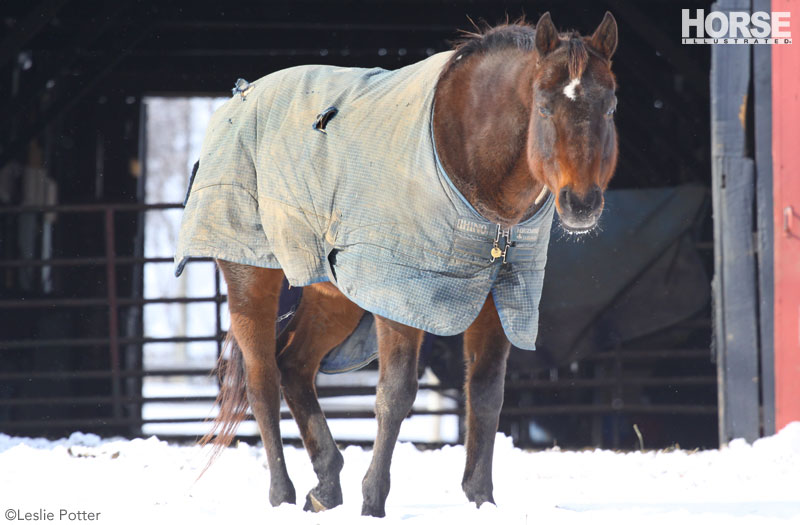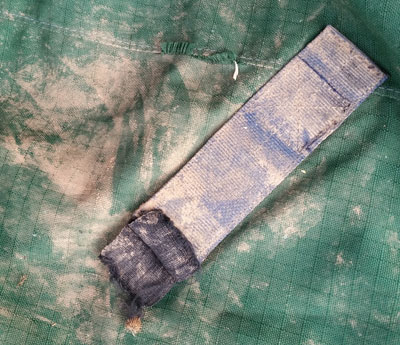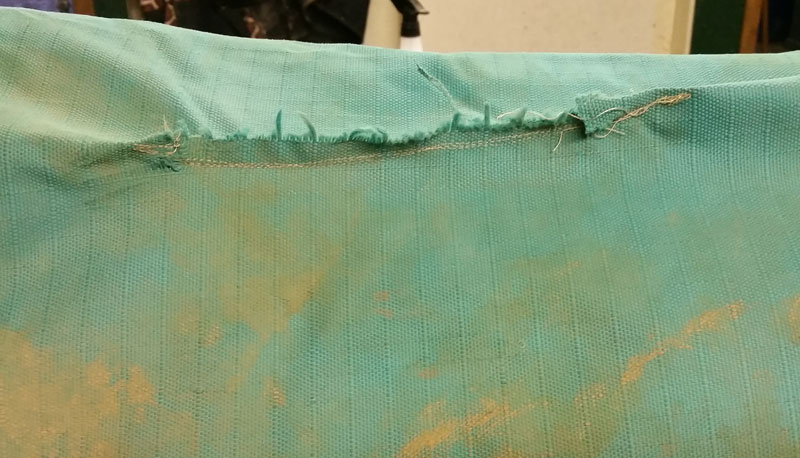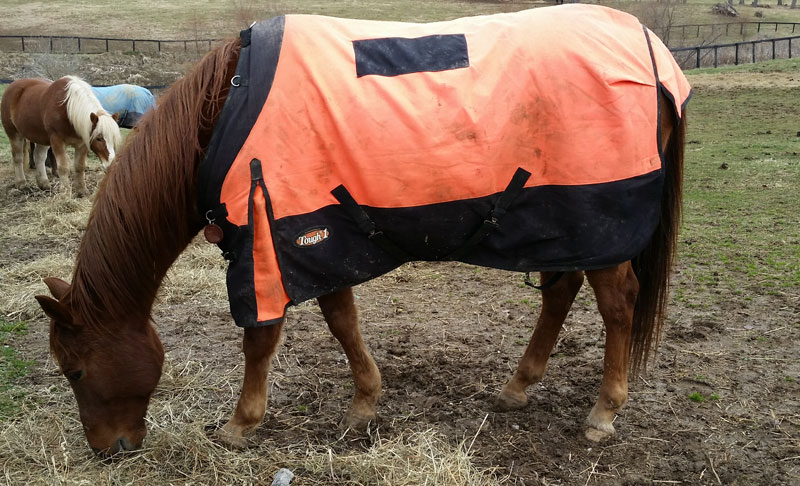
By now, your horses have probably been wearing their blankets for quite some time. Their winter clothes are most likely showing some wear and tear in the form of missing straps, small holes or larger tears.
The middle of winter is not the easiest time to send blankets off to professional washing and repair services, especially if you don’t have a spare to put on your horse in the meantime. With a little ingenuity, you can handle emergency patch-up and repair jobs on your own.
Before you begin any repairs, your blanket, or at least the area you are repairing, needs to be clean. Many times it’s not possible to take the blanket to a laundry at that exact time (because, let’s be honest—horses seem to ruin things at the most inopportune times, like right before the holidays or you travel out of town). Also, the rip might be so large that you might fear if you wash it that the fill will all fall out!
In these cases, it’s necessary to make sure that at least the edges of where you will be repairing and a few inches on either side are clean and dry. You can use soap and water, but spot cleaning with rubbing alcohol should suffice.

How to Repair Broken Belly Straps on Winter Blankets
Many horses that love to run, buck and roll will come in from the field with missing blanket hardware in the form of missing belly or leg straps or broken chest buckles. These issues can be the most difficult to repair on your own, as most home sewing machines are not able to sew through the stuffing and the straps to hold them securely (though it’s worth a shot!). In addition, some talented horses are able to rip off entire belly straps, leaving you with nothing but a short section of strap that you’re unable to do much with.
In this case, you can use an elastic blanket surcingle. Used behind the withers, the surcingle can help hold the blanket in place until you can more properly repair the missing belly strap. If you happen to have pieces from an old blanket, you can cobble together a new strap, sewing the new piece on to the old and sewing on a new hook for the fastener. Replacement fasteners, buckles and other hardware are available at tack shops and local farm and feed stores, as well as online.
With any blanket repair, the heavier the thread, the better, as it will be more durable. If you are trying your hand at sewing on a belly strap, you can use braiding thread, dental floss (really!) or fishing line. It can be very difficult to get a needle all the way through multiple layers of fabric and straps, so be careful; a blunt needle is easier to wield, but can be harder to work through the fabric. Hand-sewing the T-strap in place in between the frayed ends of elastic is also possible, or you can use a sewing machine to sew it in place.
You can help prevent the repaired blanket strap from coming loose by using the small, black rubber bands that fit over the T-buckle to help them stay put. By preventing the straps from coming loose, you eliminate the majority of the chance he will rip it off again.
How to Fix Loose Leg Straps
Leg straps can be a more difficult repair as they involve stitching through additional layers of fabric; a heavy-duty sewing machine is usually necessary to securely fasten these back to the body of the blanket. When reattaching the leg straps, consider using heavy canvas or leather as backing to make the repair more secure and less prone to re-tearing. If you don’t have a heavy-duty machine at your disposal, some shoe repair shops will sew leg straps back onto clean horse blankets.
If your horse has completely torn off one leg strap, you can tighten the remaining strap as much as possible and see if it will stay in place. If all else fails, or if you know your horse plays hard, use baling twine from one rear leg strap hook to the other as a tail cord to keep your horse’s blanket in place until you can have it more permanently repaired.

How to Repair Tears in a Horse Blanket
Large rips and small holes in the body of the blanket are common, but can be the easiest to repair. If your blanket is made of polyester, consider using a lighter to (carefully) seal the hole. It goes without saying—but we’re going to say it anyway—the blanket should not be on the horse at the time of the repair.
For blankets made of other materials, consider using a duct tape patch to temporarily hold the tear together. A waterproof patch (available at some tack shops) also works well, as does an iron-on jean patch from a crafting supply store. Simply trim the patch to the size of the tear, iron on and let cool completely before placing back on your horse.
Glue is also an option to repair tears and small holes; just be sure the glue has time to set completely before putting the blanket back on your horse—usually overnight.
No matter what repair you make, tape, jean or iron-on patch, sealing the repair with waterproofing is never a bad idea. You can purchase spray-on waterproofing (the easiest and quickest to use) at camping supply stores where they keep the camping equipment (double-check that the type of waterproofing you purchase is useable on your blanket’s material). Be sure to check at what temperature is best to use the waterproofing; if it recommends over 50 degrees F, you may need to take the blanket into a garage or other climate-controlled area to make sure the spray works.
For very large tears, sewing is best, but you don’t have to be an expert seamstress—the repair just has to be functional. A straight or zig zag stitch is easiest, and hand sewing is always an option.

Know When to Give It Up
Finally, if your horse is basically naked from his withers to his hips, it may be time to call it quits on your repairing abilities. If you do choose to trash your blanket, be sure to cut off the hardware (including leg or belly straps, if they are salvageable) and save them for later use. It also might be wise to cut some portions of the blanket itself to save as repair patches for the next blanket.
Liked this article? Here are others you’ll enjoy:






Great tips! So glad my horses have thick coats and don’t need blankets. Phew!
I usually do not have a problem with torn blankets except for the time my Standardbred mare accidently got her leg strap caught on her water bucket handle and she spooked when she couldn’t get free. the door was open to the paddock when she bolted out and I heard a loud rip!
I always keep an extra clean blanket on hand when they get too dirty, so I put another on and made sure after that her leg straps were always snug enough not to snag on anything again.
we often cover all our buckles with electrical tape or hockey tape , it keeps the straps from coming loose if you cant check on a daily basis